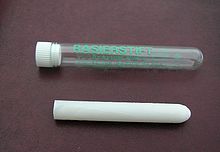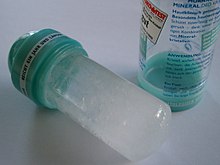Alum
![]()
Alum is a redirect to this article. For aluminium sulphate, wrongly called alum in paper production, see there.
Alum (from Middle High German alūn, from Latin alumen 'bitter alum salt', 'alum', from Indo-Germanic alu- 'bitter'; English: Alum, French: Alun) was originally called only a potassium-aluminium salt (KAl(SO4)2), the crystallised hydrous sulphuric acid double salt (combined metal sulphate) of potassium and aluminium (also potassium aluminium sulphate). In the meantime, the corresponding ammonium aluminium salt is also sometimes referred to in this way, while the name alum applies to all sulphuric acid double compounds of the same chemical constitution, in which case the metal occurring for potassium or aluminium is placed in front of the name, for example chromium alum for the sulphuric acid double salt of potassium and chromium.
Alums always have the composition MIMIII(SO4)2-12 H2O, where MI can be monovalent metal cations such as the alkali metals sodium, potassium, rubidium and cesium - with the exception of lithium, since it cannot be incorporated without loss of stability - thallium or also ammonium and its organically substituted derivatives; MIII can be the following triply positively charged metal cations: Aluminum, Gallium, Indium, Titanium, Vanadium, Chromium, Manganese, Iron, Cobalt, Rhodium, Iridium and to some extent Thallium. The typical alums are those with aluminum, chromium and iron. All alums crystallize in the cubic system, mostly in the octahedral form and always with 12 molecules of crystal water. Furthermore, only two very unstable alums are known from sodium, the aluminium and the chromium alum.

A crystal of ammonium iron alum
-180767.jpg)
Kalialaun as a mineral, found in Utah
History
The Egyptians already used alum as a flame retardant for wood. Pieces found date back to 450 B.C. The Romans also used it for this purpose and additionally mixed it with vinegar. Furthermore, they used it as a deodorant: "It removes the stench under the armpits as well as sweat".
Alum was also used in alchemy around the 11th century.
During the 14th and 15th centuries, the Medici family of Florence had exclusive rights to this mineral, which was used to dye cloth. Together with the church, they operated the first European alum works in Tolfa.
In 1578 Horatio Palavicino, a banker who had converted to Protestantism and whose family administered the papal alum monopoly, sold the entire stock to the Dutch in exchange for a promissory note signed by Queen Elizabeth of England for £29,000 and the granting of the import monopoly. England had long suffered from the fact that the monopoly then rested with the Papal States, and imports, which were important to the cloth industry for fixing dyes, were hampered after the Church broke away from England under Henry VIII. Prospecting was then done at home and Thomas Chaloner set up his own alum industry in Yorkshire from 1607 based on alum slate.
In the 1830s, Leopold Bleibtreu (1777-1839) and his brother Abraham (1775-1852) operated the largest alum smelting company in Prussia in what is now the Holzlar district of Bonn.

Extinguishing bomb: The mixture of fine alum powder and a little gunpowder was ignited by a sulfur thread at the opening (around 1700)
Usage
Alum is used in tanning to whiten hides, in calico printing and in fabric dyeing for mordanting (see also dyeing plants). It is also used for waterproofing fabrics, which are then drawn through oleic acid, for clarifying liquids, and so on. In many cases the alum must be entirely free from iron, the presence of which is detected by means of blood liquor salt (blue dyeing). In papermaking, dyeing, and white tanning, aluminium sulphate itself is now frequently used instead of alum, and is therefore often called concentrated alum.
- Ammonium alum (Alumen amoniacale), (NH4)Al(SO4)2-12 H2O, is prepared in the same way as potash alum, by adding ammonium sulphate to aluminium sulphate instead of potassium sulphate. It contains 49.62% water of crystallization, is more readily soluble in cold water than the ordinary potash alum, and is used like the latter. The content of anhydrous aluminium sulphate in potash alum is 10.8 %, in ammonium alum 11.9 % and in so-called concentrated alum (see above) 15.4 %. Ammonia alum, which, incidentally, is often a mixture with potash alum, emits the pungent odour of ammonia (ammonia solution) when treated with caustic potash.
- Sodium alum is rarely used because it quickly weathers, becomes cloudy, and eventually decomposes to a white powder.
- Chromalaun, KCr(SO4)2-12 H2O (Alumen chromicum), in which the aluminium is replaced by chromium, is used in dyeing and tanning. It is often formed as a waste product in the manufacture of tar dye, in which chromic acid is used as an oxidizing agent, and consists of octahedra which are almost black in incident light and dark red in transmitted light, and which dissolve in water with a violet colour.
Alum is also used to make plasticine. The most common application in daily life is the styptic pencil, which is used as an astringent to stop bleeding. Alums were already used in medicine in ancient times and the Middle Ages. But alum is also used in gardening. Here hydrangeas are fertilized with alum to produce a violet or blue coloration of the flowers. In Thailand, for example, it is added to water to bind the suspended matter in it and thus clarify the earthy water. It is also used as a deodorant (French Pierre d'Alun). Alum is wetted and applied to the areas to be deodorized. In China, alum powder (Chinese 明矾粉, pinyin míngfánfěn) has been used for centuries to make the fried breakfast pastry youtiao (Chinese 油条, pinyin yóutiáo).
- Crystal growers often use potassium aluminum alum and potassium chromium alum. Both alums can be grown into centimeter-sized crystals.

Alum shaving pencil

Alum deodorant crystal

In this Roman amphora, found in Bliesbruck, alum was transported from the Lipari Islands for dyeing wool. Pompeii exhibition 2007, European Cultural Park Bliesbruck-Reinheim
Search within the encyclopedia